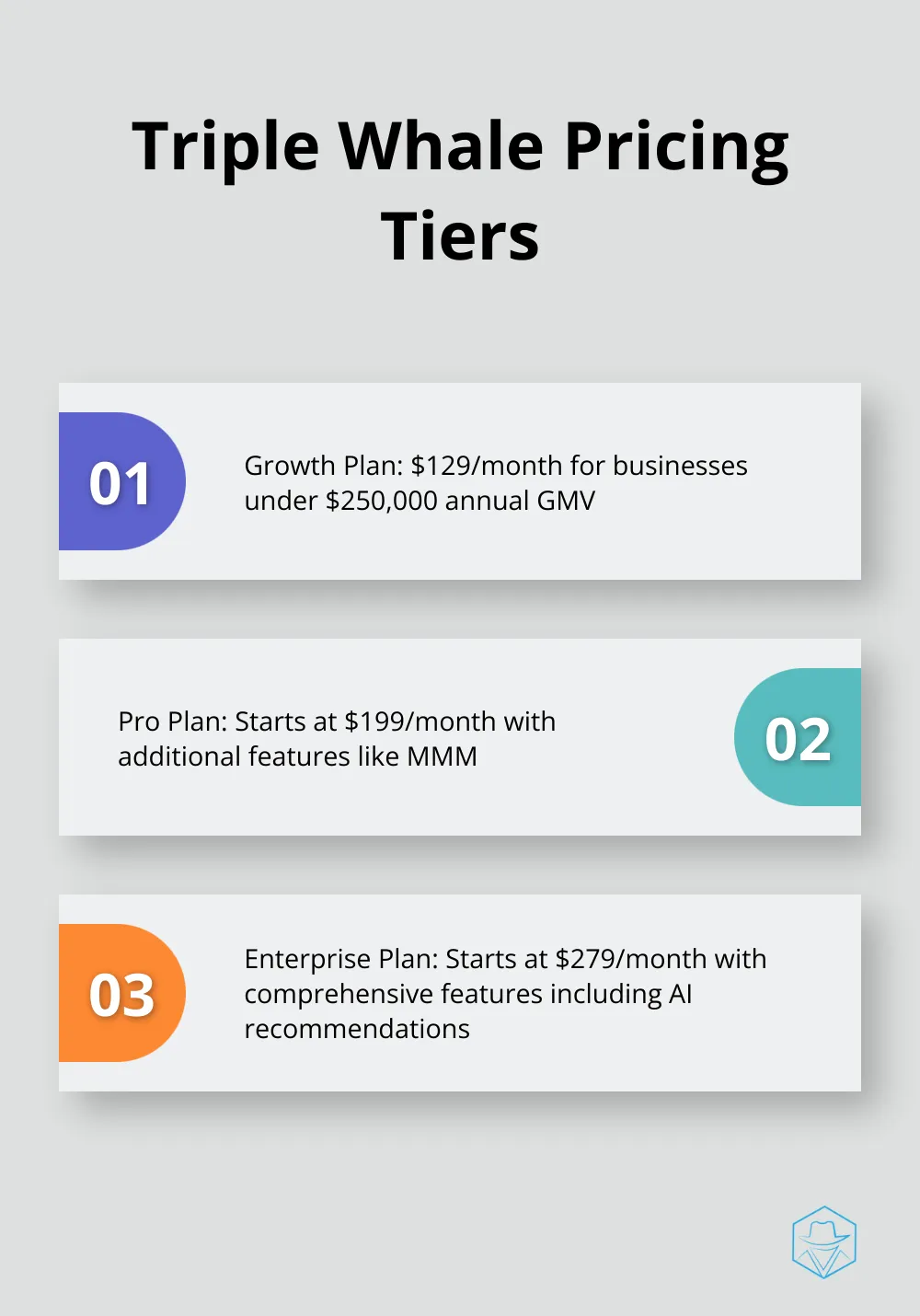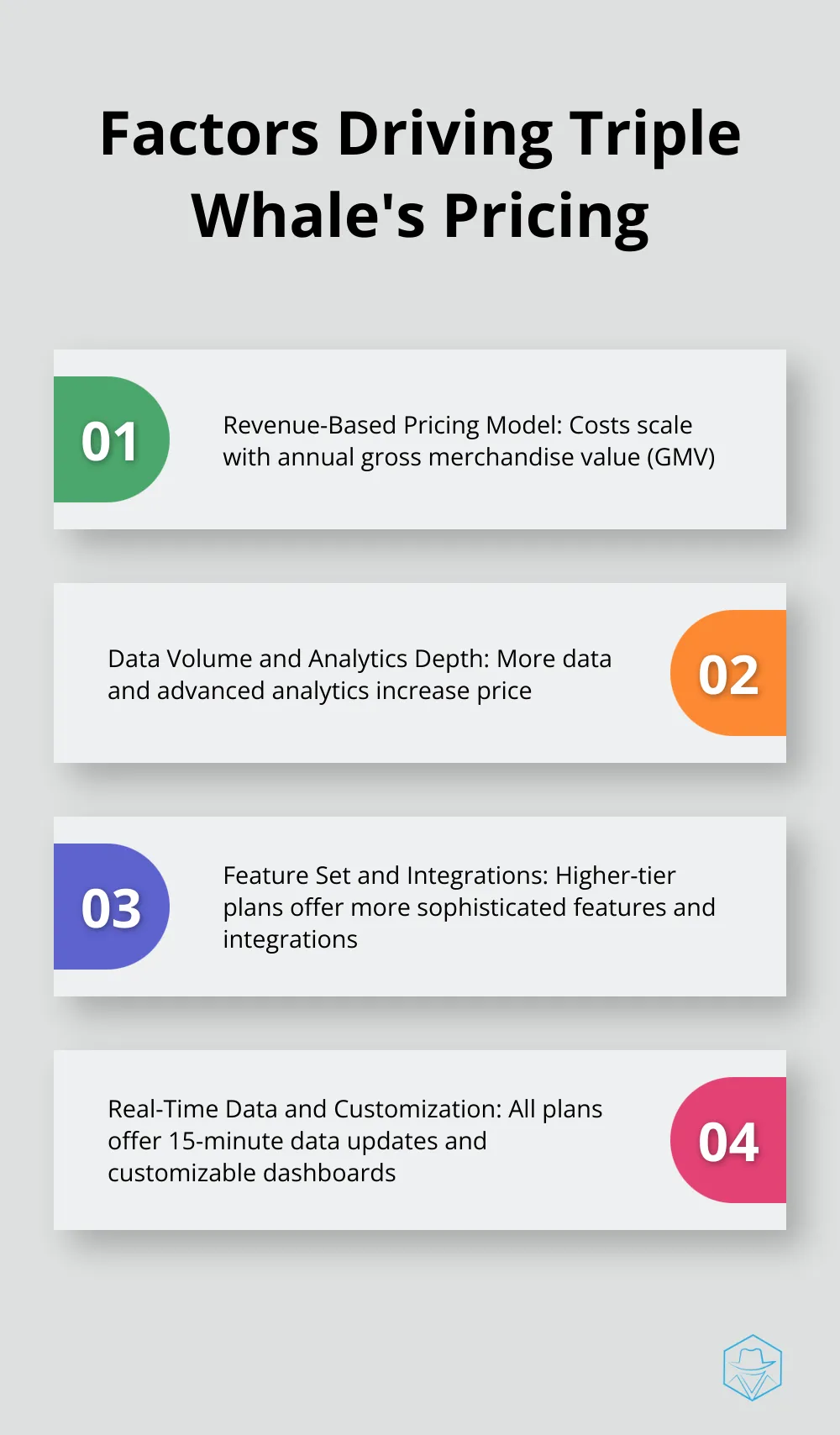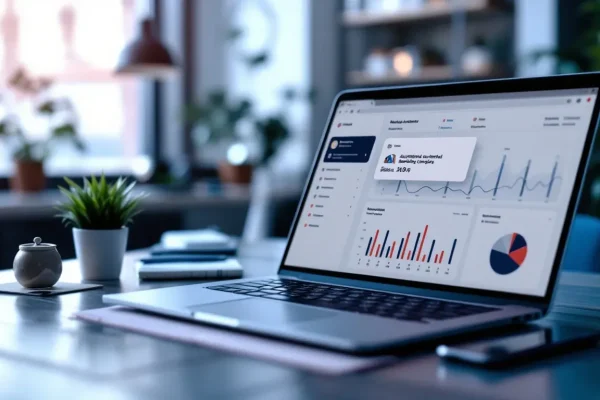Triple Whale Pricing: What You Need to Know

At Drop Cowboy, we understand the importance of making informed decisions about your marketing tools. Triple Whale has become a popular choice for e-commerce businesses, but understanding its pricing structure is crucial for maximizing value.
In this post, we’ll break down Triple Whale pricing, explore the factors that influence costs, and provide tips on choosing the right plan for your business needs.
How Much Does Triple Whale Cost?
Pricing Tiers Overview
Triple Whale structures its pricing based on annual gross merchandise value (GMV). Plans start at $129 per month for businesses with annual earnings under $250,000. As businesses grow, the cost increases, potentially reaching $4,499 per month for companies approaching $50 million in annual revenue.

Entry-Level Growth Plan
The Growth plan, priced at $129 per month, offers essential tools for tracking key metrics and integrates with all marketing channels. This plan suits small businesses that want to gain insights into their marketing performance without significant financial investment.
Advanced Pro and Enterprise Plans
The Pro plan starts at $199 per month and includes additional features like marketing mix modeling (MMM) for optimized budget allocation. The Enterprise plan, starting at $279 per month, provides the most comprehensive feature set, including AI-powered recommendations and cohort analysis.
Unique Value Propositions
Triple Whale’s pricing includes Moby Agents (AI-powered assistants that optimize customer acquisition and retention) in paid plans. These agents work continuously to improve marketing performance, which may justify the higher price point for businesses that can effectively use this technology.
Real-Time Data and Customization Features
All Triple Whale plans offer real-time data updates every 15 minutes, a feature not common among competitors. This immediacy in data reporting can significantly impact businesses that need to make quick, informed decisions based on the latest performance metrics.
The platform also includes a no-code dashboard builder, allowing users to customize their analytics view without technical skills. This feature enhances usability and ensures businesses can focus on their most important metrics.
While Triple Whale’s pricing may appear high for smaller businesses, the potential return on investment through improved marketing efficiency and data-driven decision-making could offset the costs. However, businesses must carefully evaluate their needs and budget constraints before selecting a plan.
As we move forward, let’s examine the factors that influence Triple Whale’s pricing structure and how these elements can impact your choice of plan.
What Drives Triple Whale’s Pricing?

Revenue-Based Pricing Model
Triple Whale bases its pricing structure primarily on a company’s annual gross merchandise value (GMV). This approach ensures that businesses pay for a service level that matches their operational scale. A company with $1 million in annual revenue will likely need more advanced features and higher data processing capabilities compared to a startup generating $100,000 per year.
This model benefits growing businesses, allowing them to start with a more affordable plan and upgrade as their revenue increases. However, as your business expands, your Triple Whale costs will also rise. We recommend a regular review of your Triple Whale plan to ensure it continues to provide the best value for your current business size.
Data Volume and Analytics Depth
The amount of data your business generates and the level of analytics you require significantly impact Triple Whale’s pricing. Higher-tier plans offer more sophisticated analytics capabilities, including marketing mix modeling (MMM) and cohort analysis. These features prove particularly valuable for businesses with complex marketing strategies or those operating in highly competitive markets.
If you run multiple marketing campaigns across various channels, you’ll benefit from the advanced attribution models and detailed performance insights offered in the Professional plans (starting at $539 per month). These plans provide a comprehensive view of your marketing efforts’ effectiveness.
Feature Set and Integrations
The number and sophistication of features and integrations you need also play a role in determining your Triple Whale costs. While all plans include essential tools (like integration with marketing channels and instant analytics), more advanced features come with higher-tier plans.
For instance, the AI-powered Moby Agents (available in paid plans) can significantly enhance your marketing optimization efforts. These agents work continuously to improve customer acquisition, conversion rates, and retention. If your business relies heavily on data-driven decision-making, this feature alone could justify the higher cost of advanced plans.
Moreover, Triple Whale’s integration capabilities with over 50 platforms (including Shopify, BigCommerce, and WooCommerce) can streamline your data gathering process. The value of these integrations should factor into your decision when considering Triple Whale’s pricing.
Real-Time Data and Customization
All Triple Whale plans offer real-time data updates every 15 minutes, a feature not common among competitors. This immediacy in data reporting can significantly impact businesses that need to make quick, informed decisions based on the latest performance metrics.
The platform also includes a no-code dashboard builder, allowing users to customize their analytics view without technical skills. This feature enhances usability and ensures businesses can focus on their most important metrics.
As you weigh the factors that influence Triple Whale’s pricing, it’s important to consider how these elements align with your specific business needs and goals. In the next section, we’ll explore strategies to maximize the value you receive from your chosen Triple Whale plan.
How to Get the Most Out of Triple Whale

Align Your Plan with Business Goals
Define your e-commerce objectives clearly. Focus on customer acquisition, retention, or lifetime value to guide your Triple Whale plan choice. If customer retention is your priority, consider the Pro plan’s cohort analysis feature.
Assess your current marketing stack. Triple Whale integrates with over 50 platforms (including Shopify and Google Ads). List your tools and check their compatibility with Triple Whale. This ensures you avoid paying for redundant features and maximize Triple Whale’s integration capabilities.
Leverage Key Features for ROI
Master the core features of your chosen plan. Use the Trends Tool (available across all plans) to set realistic performance goals and identify marketing gaps. This tool provides industry benchmarking across a database of over 11,000 customers.
For paid plans, utilize the Moby Agents. These AI-powered assistants optimize customer acquisition and retention 24/7. Set up your Moby Agents to focus on critical KPIs (such as reducing customer acquisition costs or improving ROAS).
The no-code dashboard builder is a powerful feature. Customize your dashboard to display important metrics prominently. Include blended ad spend, CPA (Cost per Acquisition), and net profit. This easy access to key metrics enables quick, data-driven decisions.
Scale Your Plan Strategically
Your Triple Whale plan should evolve as your business grows. Set up quarterly reviews of your plan to ensure it aligns with your needs. Look for indicators that you’ve outgrown your current plan:
- Hitting data processing limits
- Needing more advanced analytics features
- Requiring additional user access
Calculate the potential ROI when considering an upgrade. For example, if moving to the Advanced plan at $259/month gives you access to marketing mix modeling (MMM), estimate your potential savings from optimized marketing budget allocation.
Triple Whale’s pricing ties to your annual GMV. As your revenue grows, your costs will increase. Plan for this in your budget and ensure that Triple Whale’s value scales proportionally with the increased cost.
Maximize Integration Capabilities
Take full advantage of Triple Whale’s extensive integration options. Connect your e-commerce platform, email marketing tools, and advertising accounts to create a comprehensive data ecosystem. This integration allows for more accurate attribution modeling and deeper insights into your marketing performance.
Try to automate as many processes as possible using Triple Whale’s tools. Set up automated reporting and alerts for key metrics to save time and ensure you never miss important trends or changes in your business performance.
Final Thoughts
Triple Whale’s pricing structure offers options for businesses of various sizes and needs. The platform scales its offerings from the entry-level Growth plan at $129 per month to the comprehensive Enterprise plan at $4,499 monthly for high-revenue companies. When you select a Triple Whale plan, you should consider your current revenue, data analysis needs, and growth projections.
The cost-effectiveness of Triple Whale depends on how well you use its features to drive marketing efficiency and revenue growth. You can maximize the value from Triple Whale’s analytics platform by aligning the chosen plan with your business goals and leveraging key features for ROI. Triple Whale offers powerful e-commerce analytics, but you should explore complementary tools to enhance your overall marketing strategy.
For businesses that want to improve their communication and outreach efforts, Drop Cowboy provides innovative solutions for ringless voicemail and SMS marketing. Drop Cowboy’s features (such as voice cloning, global message delivery, and campaign automation) can complement your analytics platforms to boost customer engagement and drive results. The true value of any marketing tool lies in its ability to generate actionable insights and drive business growth.
blog-dropcowboy-com
Related posts

April 17, 2025
Revolutionize Your Agency with Marketing Automation
Transform your business with marketing agency automation. Explore practical tips and boost efficiency to drive growth in your agency today.

March 8, 2025
Marketing Strategy: Text and Cases Explained
Explore effective marketing strategy text and cases. Discover practical tools and insights for successful campaigns with real-world examples.

March 5, 2025
Best Ringless Voicemail Apps for Your Business
Explore top ringless voicemail apps to boost business communication and efficiency. Discover features, benefits, and how they can fit your needs.

March 28, 2025
Effective Marketing Automation Strategies for 2025
Explore top marketing automation strategies for 2025 and transform your business approach with data-driven insights and proven techniques.

February 28, 2025
How to Leverage Text Marketing for Small Businesses
Boost sales with small business text marketing. Reach more customers, engage effectively, and drive growth through proven strategies and practical tips.

March 29, 2025
B2B Marketing Automation: Driving Business Growth
Boost business growth with marketing automation for B2B. Explore strategies, drive efficiency, and enhance ROI through automated marketing solutions.